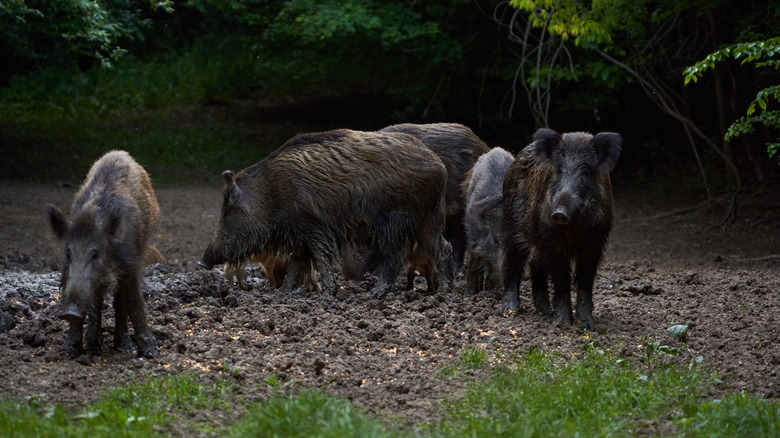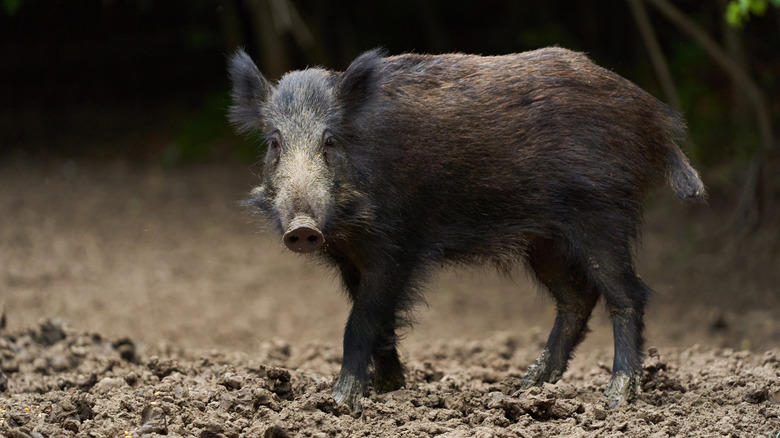The Invasive Species That's Destroying Texas
When you think of invasive species, you might typically think of things like insects, plants, or even bacteria. But there is an unlikely scourge in the United States: pigs. More specifically, wild pigs, which are currently presenting major issues for the Lone Star State in particular.
Anything introduced into an ecosystem from which it didn't originate is considered an invasive species, and they can threaten many aspects of their new environment. While some can die out due to their unfamiliar surroundings, many invaders face a lack of predators in their adopted ecosystem and therefore proliferate with ease — causing significant problems for the land and existing species around them. Invasive species can endanger other organisms and damage ecosystems, while also creating economic problems as a result.
Such is the case with wild pigs — also referred to as feral hogs — which have been menacing Texas for decades, and they are now posing major risks to the state's water quality, agriculture, wildlife, natural environment, and economy.
Pigs are not native to America
It might not seem like it today, but pigs are not actually native to North America. The animals originated in Europe and Asia before being introduced to North America prior to the establishment of the United States. All the way back in 1493, Christopher Columbus brought the creatures to the islands of the Caribbean. But the man chiefly responsible for pigs making it to what is now the mainland United States was Spanish explorer Hernando de Soto, who traveled across the southeast of the continent from Florida to Texas in 1539, bringing with him a large supply of hogs from Cuba.
As de Soto traveled across the land, he left pigs behind, sometimes due to the animals escaping, and sometimes intentionally in order to establish a source of food for future trips. In 1542, the expedition arrived in Texas, having spread pigs all the way from Florida. While in the land that would become the Lone Star State, de Soto lost multiple pigs at each camp he set up, introducing the creatures to the area and unwittingly laying the groundwork for a major invasive species issue that would plague Texas from its annexation in 1845 and far into the future.
Today, there are an estimated 6 million wild pigs in the United States, and well over 1 million of them are thought to be in Texas.
Wild pigs became a major problem for Texas in the 1980s
While wild pigs existed in Texas long before the state was even founded, they only became a major issue in the 20th century. In fact, the population of feral hogs in Texas was relatively controlled up until the 1980s when the animals' numbers exploded. Prior to this, Eurasian wild boars had been bred and released into the state during the 1930s for hunting purposes, but even then, the numbers remained relatively steady.
Part of the problem is that wild pigs are intelligent and adaptable enough to often evade attempts to curb their numbers. What's more, the animals didn't evolve in North America, and so they have no natural predators. On top of that, wild pigs have the highest reproductive capability of any hoofed animal. A sow can have two litters of four to eight piglets in 12 to 15 months. But there were some specific reasons for wild pigs becoming so prevalent in Texas during the '80s.
Hunters — who affect the environment in their own way — struggled to capture the creatures in the wild, so feral hogs were actually raised on ranches in the state where customers would pay to hunt the animals. After capturing the pigs, many hunters would simply release them in other parts of the state. What's more, game ranchers would try to attract deer with feed, to which the wild pigs helped themselves, leading to higher reproduction rates among the species. Another driving force behind the population explosion in the 1980s was a marked improvement in agricultural techniques that reduced disease among domestic pigs — something that ultimately transferred to their feral counterparts.
Wild pigs and their diet cause major problems
Since the 1980s, wild pigs have continued to proliferate. As reported in 2023, 99.6% of Texas' 254 counties are now home to the feral animals. Meanwhile, studies noted that 2.6 million of the creatures were estimated to be living in Texas as of 2016 — a figure that has grown to more than 3 million in the years since.
So, wild pigs are everywhere in Texas, but what risk do they actually pose? Well, the invasive species cause myriad issues, impacting everything from water quality to crops, wildlife populations, and even property. The animals are omnivores, which means they eat everything from roots to insects, and even small animals. The feral creatures will also eat eggs and have been known to consume calves, lambs, fawns, and kids (baby goats). While eating the young of other animals might be the most immediately abhorrent aspect of the feral hogs' diet, just as destructive (if not more so) is the animals' penchant for eating acorns and flora, which means they are taking those resources from native species like white-tailed deer and turkeys.
Wild pigs are destroying natural environments
It isn't just the wild pig's diet that creates issues. The animals can also spread invasive plant species such as tallow trees simply by moving around the state with the seeds attached to their body. They also cause an immense amount of damage to the natural environment, with crop damages and control costs estimated to be $1.5 billion in the U.S. and around $52 million in Texas, annually.
The pigs also cause damage in and around streams, where they tend to congregate. Not only do they introduce bacteria to the water, they can increase sediment loads, erode the land around water bodies, prompt the growth of more algae blooms, and deplete the oxygen in the water, which has obvious consequences for other species in the area and Texas' ecosystems generally speaking. What's more, the animals can carry a disease known as swine brucellosis, which is capable of transferring to humans, but thus far, the disease has only jumped to humans when hunters cleaning pig carcasses while they have an open wound.
Wild pigs in the city
As of 2019, wild pigs had gone from being a rural problem to an urban and suburban problem. The animals were seemingly becoming more willing to venture into urbanized areas, bringing all the problems of an invasive species into the heart of communities across Texas.
2023, for example, saw wild pigs causing havoc in many suburban neighborhoods, including in the city of Fair Oaks. Sitting just outside San Antonio, Fair Oaks was tormented by the animals in October of that year, where they damaged eight properties, tearing up yards and sprinkler systems, and generally seeming unperturbed by the presence of humans.
This wasn't just an isolated incident either. Back in 2019, Texas A&M reported on the increasing encroachment of feral hogs into urbanized areas. John Tomecek, AgriLife Extension wildlife specialist, suggested the issue was partly down to both human and wild pig populations increasing, making interactions between the two much more likely. But the pigs' apparent increase in confidence is also a concern, with Tomecek adding, "Wild pigs are becoming more brazen and ranging into populated areas. They realize we are not going to do anything about them."





